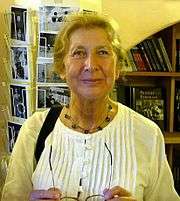Markéta Luskačová

foto: Stanislav Tůma junior
Markéta Luskačová (b. Prague, 1944) is a Czech photographer known for her series of photographs taken in Slovakia, Britain and elsewhere. Considered one of the best Czech social photographers to date, since the 1990s she has photographed children in the Czech Republic, Slovakia, and also Poland.[1]
Biography
In 1968 Luskačová graduated from Charles University in Prague with a thesis on religion in Slovakia.[2] During her stay in Slovakia, she became familiar with the old Christian rites and decided to return with a camera to document the surviving traditions. Her thesis was titled Poutě na Východním Slovensku (Pilgrimages in East Slovakia).[3] In the Pilgrimages cycle she mainly focused on the Slovak village of Šumiac.[4] Following that she studied photography at FAMU, in this period photographing in Slovakia and Poland.
From 1970 to 1972, Luskačová photographed stage performances of the Za branou theatre, founded by director Otomar Krejča. However, the theatre was banned by communists in the spring of 1972. The same year, she was allowed to display the cycle Pilgrims in the Gallery of Visual Arts in Roudnice nad Labem (the curator of the exhibition was the photography theorist and art historian Anna Fárová). In 1971, Luskačová married the poet Franz H. Wurm (native of Prague and a British citizen). Wurm, terrified by the "Normalization" in Czechoslovakia, left the country and Luskačová asked the state authorities for permission to visit her husband abroad. After several short visits she received a form for emigration (1975) and went to live in England.[3] However, in an interview she claimed: "Bohemia, Prague and Šumiac have never ceased to be my home. I always took my life abroad as a kind of stopgap that stretched to be a considerable part of my life."[3]
In the 1970s and '80s, the communist censorship attempted to conceal her international reputation. Her works were banned in Czechoslovakia, and the catalogues for the exhibition Pilgrims in the Victoria and Albert Museum were lost on their way to Czechoslovakia.
Luskačová started photographing London's markets in 1974.[5] In the markets of Portobello Road, Brixton and Spitalfields, she "[found] a vivid Dickensian staging".[2]
Selected exhibitions
- "Photographs from the Beaches" (with Sirkka-Liisa Konttinen). Side Gallery (Newcastle), 1978.[6]
- "North Tyneside" (with Isabella Jedrzejczyk, Sirkka-Liisa Konttinen and Graham Smith). Side Gallery (Newcastle), 1981.[6]
- "Pilgrims". Side Gallery (Newcastle), 1985.[6]
- "Primary Concerns". Side Gallery (Newcastle), 1989.[6]
- "Photographs of Spitalfields". Whitechapel Art Gallery (London), 1991.[7]
- "Poutníci". Fotografická galerie Fiducia (Ostrava), 2001–2002.[8]
- "No Such Thing as Society: Photography in Britain 1968–1987." Aberystwyth Arts Centre; Tullie House, Carlisle; Ujazdów Castle, Warsaw; Luskačová is one of a number of photographers shown.[9]
- "The Photogeny of Identity – The Memory of Czech Photography", National Museum of Photography (Jindřichův Hradec), 2008.[10]
- "The Third Side of the Wall: Photography in Czechoslovakia 1969–1988 from the Collection of the Moravian Gallery in Brno." Moravian Gallery in Brno, 2008–2009.[11]
Books and exhibition catalogues
- Pilgrims: Victoria & Albert Museum. London: Victoria and Albert Museum, 1983. ISBN 0-905209-60-5. Exhibition catalogue.
- Pilgrims. London: Arts Council of Great Britain, 1985. ISBN 0-7287-0443-9. Exhibition catalogue, with text by John Berger.
- Judlová, Marie. Markéta Luskačová. Prague: Galerie hlavního města Prahy, 1991.
- Markéta Luskačová: Photographs of Spitalfields. London: Whitechapel Gallery, 1991. Exhibition catalogue.
- Markéta Luskačová: Fotografie ze Spitalfields (Londýn 1974–1990). Brno: Dům umění města Brna, 1995. ISBN 80-7009-074-X.
- Unknown Remembered: Photographs of Children, 1968-98. [Prague]: Galerie G4, 1998. Exhibition catalogue, with text in Czech and English by Colin Osman.
- Markéta Luskačová. Prague: Torst, 2001. ISBN 80-7215-129-0. (Czech) (English) Book with introductory texts by Marie Klimešová, Gerry Badger, and Josef Topol.
- O smrti, o koních a jiných lidech / On Death and Horses and Other People: Maškary–Masks: 1999–2010: Roztoky–Únětice. [Roztoky], Czech Republic: Sdružení Roztoč, 2011. ISBN 978-80-254-8402-9. (Czech) (English) Catalogue of an exhibition, with short texts by Howard Bossen and Robert Silverio.
Sources
- Birgus, Vladimír; Mlčoch, Jan (2010). Czech Photography of the 20th Century. Prague: Kant; Museum of Decorative Arts in Prague. ISBN 978-80-7437-027-4. (Czech) (English)
- Mellor, David Alan. No Such Thing as Society: Photography in Britain 1967–1987: From the British Council and the Arts Council Collection. London: Hayward Publishing, 2007. ISBN 978-1-85332-265-5.
- coll. (2006). Fotogenie identity/The Photogeny of Identity. Prague: Kant; Prague House of Photography. ISBN 80-86970-12-4. (English)
References
- ↑ "Urban Encounters: Rethinking Landscape". Goldsmiths, University of London. Retrieved 11 April 2011.
- 1 2 Mellor, No Such Thing as Society, p. 53.
- 1 2 3 The Photogeny of Identity (2006), p. 205.
- ↑ Birgus (2010), p. 156.
- ↑ Mellor, No Such Thing as Society, p. 154.
- 1 2 3 4 "Side Gallery Exhibitions 1977–1994", Amber Online. Accessed 15 February 2009.
- ↑ Documented in the catalogue Photographs of Spitalfields.
- ↑ List of exhibitions, 1995–2008, Fotografická galerie Fiducia. Accessed 15 February 2008.
- ↑ Press release for the exhibition, British Council. Accessed 15 February 2009.
- ↑ Exhibition notice, National Museum of Photography at Jindřichův Hradec. Accessed 15 February 2009.
- ↑ Exhibition notice, Moravian Gallery in Brno. Accessed 15 February 2009.
External links
- Official website
- Luskačová's work at World Webphoto Gallery